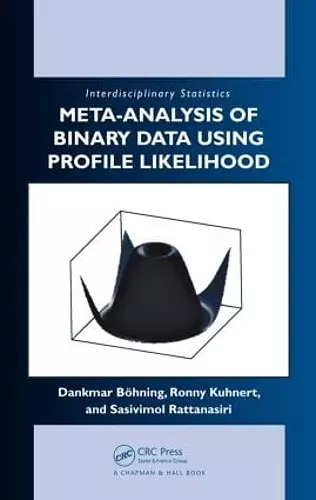Meta-analysis of Binary Data Using Profile Likelihood
Dankmar Bohning author Sasivimol Rattanasiri author Ronny Kuhnert author
Format:Hardback
Publisher:Taylor & Francis Inc
Published:27th Mar '08
Currently unavailable, and unfortunately no date known when it will be back
This hardback is available in another edition too:
- Paperback£63.99(9780367387570)

Providing reliable information on an intervention effect, meta-analysis is a powerful statistical tool for analyzing and combining results from individual studies. Meta-Analysis of Binary Data Using Profile Likelihood focuses on the analysis and modeling of a meta-analysis with individually pooled data (MAIPD). It presents a unifying approach to modeling a treatment effect in a meta-analysis of clinical trials with binary outcomes.
After illustrating the meta-analytic situation of an MAIPD with several examples, the authors introduce the profile likelihood model and extend it to cope with unobserved heterogeneity. They describe elements of log-linear modeling, ways for finding the profile maximum likelihood estimator, and alternative approaches to the profile likelihood method. The authors also discuss how to model covariate information and unobserved heterogeneity simultaneously and use the profile likelihood method to estimate odds ratios. The final chapters look at quantifying heterogeneity in an MAIPD and show how meta-analysis can be applied to the surveillance of scrapie.
Containing new developments not available in the current literature, along with easy-to-follow inferences and algorithms, this book enables clinicians to efficiently analyze MAIPDs.
"The book is very focused on the methods the authors have developed for meta-analysis. It includes a lot of technical details for solving likelihood equations. The advanced key method is based on nonparametric mixing distributions and the question how many mixing components do we have is the crucial one. ... A positive aspect is the development of the software tool. The software CAMAP can be downloaded with no costs from the website: http://www.personal.rdg.ac.uk/~sns05dab/Software.html ..." -ISCB News #49, June 2010 "The authors have succeeded in demonstrating recent developments and the utility of statistical tools for MAIPD-type meta-analysis. ... a strong background in mathematics is not needed. The material that is covered in this book can be a part of an advanced biostatistics course. The book should be accessible and useful to graduate students in biostatistics and biostatisticians working in theory as well as in applied areas. The book is well worth recommending for purchase by a library." -Journal of the Royal Statistical Society, Series A, 2010, 173 "I enjoyed reading this book. Having worked with commonly used tools of meta-analysis, I learned a new set of tools and options. The writing is clear and easy to follow. ... this is a good book that assumes only a basic knowledge of metaanalysis. Students new to the subject should find it easy to follow while old hands will find interesting new research areas. I would recommend it to anyone interested in the field." -Rafael Perera, Journal of the American Statistical Association, June 2010 "I recommend the book as a supplement for a graduate-level course in meta-analysis and for readers seeking an alternative approach to analyze MAIPD or multicenter clinical trial studies, specifically when the outcome variable is the occurrence of rare events." -Taye H. Hamza, Statistics in Medicine, 2009 "The text contains many real-world examples which add to the usefulness of the book. ... The balance between statistical theory and practical applications with CAMAP make the text suitable for private study and research." -C.M. O'Brien, International Statistical Review, 2009 "I am not aware of a more complete source for this topic. The authors' presentation of the core ideas behind the derivation and use of PML estimates is accessible to anyone familiar with standard likelihood-based estimation. The many good examples facilitate intelligent application of these ideas, and the described software makes implementation simple." -Eloise Kaizar, Biometrics, June 2009
ISBN: 9781584886303
Dimensions: unknown
Weight: 430g
206 pages